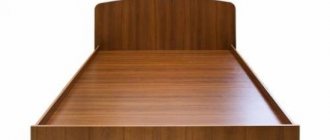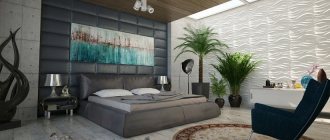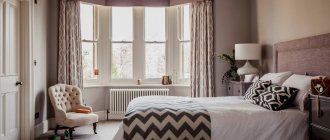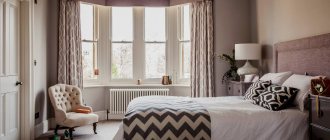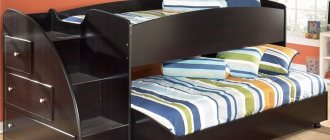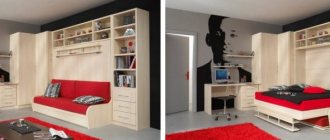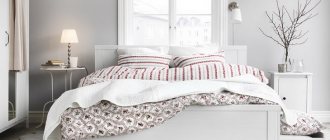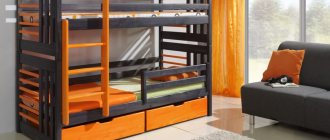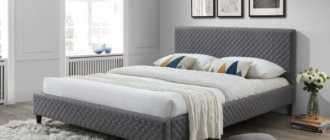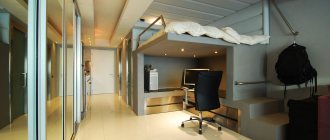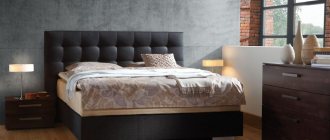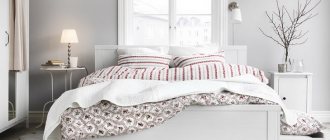Hi all! The indispensability of a bed for a bedroom is hardly worth arguing about. But a huge question regarding your health and comfortable sleep depends on how correctly the base for the bed is chosen.
There is a huge variety of designs that are made of wood, have metal components, come with drawers, have an electric drive, have a lifting mechanism, and have a reinforced base. Modern production is so extensive that choosing just one among the entire range is far from easy.
But today I propose to talk specifically about the base, which will be relevant for an adult and a child’s bed. Here the size of the furniture does not play a fundamental role.
Before this, I advise you to refresh your memory a little and read our previous material, where we talked about beds with an orthopedic base.
Components of the bed
So, our wonderful bed – what should it be like? Its design consists of:
- Frame – metal or wooden frame.
- Grounds.
- Mattress.
The headboard of the bed is a separate element that increases its comfort. The support for the mattress is the base of the bed, and the sleeping place is attached to it. An incorrectly selected base will worsen the quality of sleep and reduce the service life of the entire product. So let's talk more about this important component.
What are lamellas made of?
These structural elements can be made of wood as well as metal.
Wooden
Wooden bed slats are made from birch, linden, ash, maple, and beech. The most common and inexpensive are birch. They are light in weight and handle loads well. The most durable are beech.
Metal
They are much less common than the previous version. They differ in that they do not change their hardness throughout the entire service life. They do not bend under the mattress, but they have significant weight and can also make squeaks.
Types of bed base
Bed bases are classified according to:
- designs;
- sizes;
- manufacturing material.
Structurally, the bases can be rigid, or solid, slatted; there are also transformable bases with adjustable zones in the head, back, hips and legs. They also differ in shape. The most common, of course, is the rectangular base. But there are also round, oval and even curved ones.
How to do it yourself?
Natural wood is used to produce lamellas - birch or poplar are suitable. Making an orthopedic bed base and slats with your own hands has a great advantage - you can choose the number of slats yourself. To do this you will need:
- Mounting slats or birch plywood 1.5-2 mm thick;
- Fastenings for lamellas - rubber or foam propylene;
- Cutting tool.
The process of creating lamellas begins with a drawing and cutting out planks of the same size according to it
To make the job as simple as possible, choose smooth 100% birch plywood without knots or roughness so that you don’t have to further process it.
Solid base: pros and cons
It consists of boards or a sheet of plywood laid on a frame. Despite the fact that they are seriously inferior to rack and pinion ones, they are still found in models because:
- The design is very simple, so they are cheaper.
- Any mattress can be laid on such a base.
- For diseases of the spine, a solid foundation is recommended.
However, there are still more disadvantages to such a foundation:
- The mattress sag and sag faster on a hard base. This does not apply to a good spring mattress.
- The bottom can break under the weight of an obese person or from a child jumping.
- It is hard to sleep on such a bed, especially if the mattress is quite thin. However, if you have a good orthopedic mattress, then this drawback is completely eliminated.
- The heavy weight of the bed makes it difficult to transport. On the other hand, a bed is not a handbag that needs to be carried around with you or constantly moved from place to place.
In addition, hard bases impede ventilation, which can lead to the growth of microorganisms in the mattress. True, now manufacturers are making ventilation holes in rigid bases, and this problem has almost been eliminated.
Rigid bases are either a sheet of plywood or chipboard, or wooden boards. People choose them not only to save money - they are cheaper, but also to avoid problems with the spine. In this case, it is healthier to sleep on a hard, flat bed. Doctors believe that a rigid base plus an orthopedic mattress is the optimal tandem.
What is an orthopedic grille
The most important element of any bed is the base on which the mattress rests. Massive models made of solid boards or chipboards, beds with screened meshes are gradually becoming a thing of the past. To replace them, manufacturers offer orthopedic bases - frames with or without legs, on which outwardly curved sheets are fixed. Sometimes you can find models without sheets, which consist of special blocks.
A type of orthopedic base without legs is called an orthopedic lattice. Unlike models with legs, which are placed on the floor and can be used as an independent element, the mesh is placed on the beds provided for this side.
Bed base dimensions
Let's see what you need to know about the dimensions of the bed base. Traditionally, beds are divided according to their sizes into single, one-and-a-half, double and children's:
- Single bed – base size: 70x190; 80x190; 90x190, of course, depending on the size of the bed.
- One-and-a-half-bed – base size 110x190; 120x190; 130x190.
- Double - respectively 150, 160, 170 centimeters in width, 190-200 centimeters in length.
- Children's beds have standard base sizes: 80x140; 80x150; 60x160; 80x180, 80x190, or 90x140; 90x150; 90x160; 90x180; 90x190 centimeters.
When choosing a bed according to its dimensions, you need to know:
- The length should exceed the person’s height by 20 centimeters.
- The minimum width for a single bed is 70 centimeters, for a one-and-a-half bed - 120, for a double bed - 160.
- The mattress should be 5 centimeters narrower than the base.
- The optimal height is 60-70 centimeters.
- The legs are reliable and durable, the stability of the entire structure depends on them.
You need to be especially careful when choosing a bed for a child.
Are additional features needed?
Manufacturers provide some models with additional functionality:
- Additional storage solutions. It is convenient when there are drawers at the bottom of the crib. You can store baby clothes, diapers and other important little things in them.
- The pendulum crib sways with a light touch, and children are more likely to fall asleep in it while mom is doing business nearby. .
- A crib with a canopy will hide the baby from prying eyes and the morning rays of the sun.
- If the legs of the crib have wheels, moving it around the room is much easier.
Are additional features needed? How many mothers, so many opinions. Some people put their baby to sleep by rocking the crib, while others prefer it when the crib does not move. Each mother makes her own choice.
Children's bed with base
Whether your child sleeps soundly or restlessly depends largely on the bed. An orthopedic base is preferable for a crib because:
- It provides comfortable support for your baby's body and is neither soft nor hard.
- The slats allow air to pass through, the mattress is well ventilated.
- Environmentally friendly materials are used for the crib.
Other important criteria when choosing a children's bed: the slats should not be too narrow and should not be located very close. Also pay attention to how well all the parts are polished, whether there are any jagged edges; the lamellas should have rounded edges. Also warn your child that jumping on a base with wooden slats is prohibited, as this may cause damage. And one more thing: if you have a springless mattress, say, made of latex, then it is better to choose a bed with a solid base.
Which ones are better?
There are two types of slats: wide and narrow:
- Wide slats, about 900-1000 mm long, are installed in one row on the lattice and are often used in single or one-and-a-half beds. Slats across the entire width of the bed are suitable for springless mattresses and models with Bonnell springs.
- Narrow ones (700-800 mm) are arranged in two rows - each for one sleeping place. This type of lamella arrangement is recommended for mattresses with independent springs.
If we talk about the number of elastic panels, then the best option is 26-30 pieces for a double bed. For a single bedroom, the number of slats is half as much - 13-15 pieces. The greater the number of slats, the better: this number of slats ensures optimal flexibility of the bed base and can withstand more weight.
The lamellas differ in thickness, length, width and the distance that is formed between them. The optimal thickness of the slats is 8-10 mm, width is 5-7 cm, the length can vary depending on the width of the bed (140 cm, 160 cm, 180 cm - each of them will require slats of different lengths). There should be a distance between the slats no more than the width of one of them - about 4-7 cm.
There is another important classification - according to the type of lamella holders. Modern manufacturers attach latoflexes to special holders made of:
The slats on a strip or attached to a metal frame also move to the side, making room for a practical and lightweight fastening, which, in the event of a break, allows you to replace the latter yourself.
It is impossible to say which slats are better. If we talk about their fastening, it is better to choose rubber or polypropylene holders - they are stronger and better than their plastic counterparts.
How to insert?
The slats are attached to the metal frame of the bed in the following way: a special cap is put on it and in this form they fit into the hole (socket) at the base of the bed.
To remove the lamella or exchange a damaged part for a whole one, bend the bar and remove the fastener from the socket. Remove the middle caps on both sides and replace the latter with a new complete strip. Put the caps back on, insert one end of the lamella into the socket, bend it and place the other end into the hole on the other side of the frame.
To attach the part to the frame correctly, you will need to apply a little effort and bend the bar: it will not break.
To learn how to properly install slats on a bed, watch the following video.
